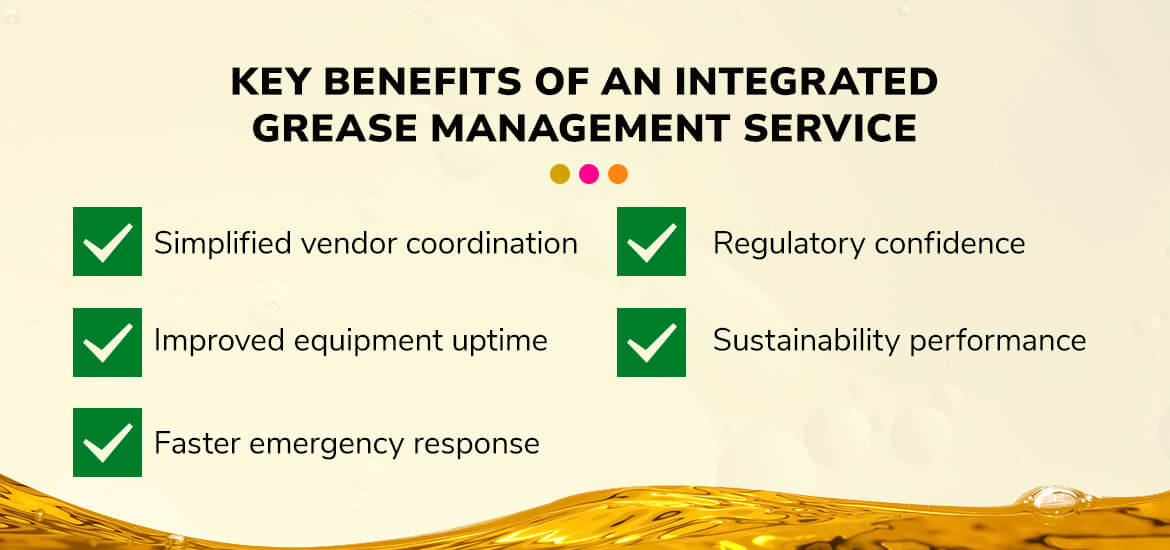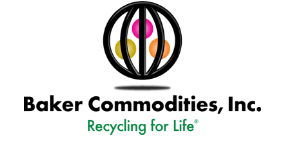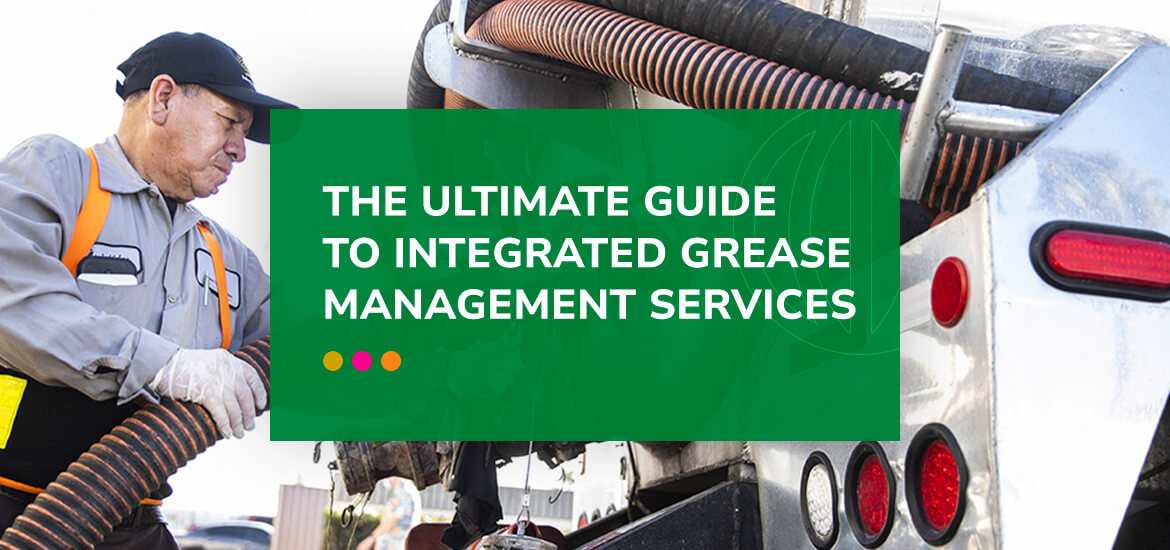The Ultimate Guide to Integrated Grease Management Services
In the hospitality, grocery and food production industries, managing grease and oil by-products isn’t optional — it’s essential. From preventing pipe blockages to staying compliant with local regulations, how your facility handles used cooking oil, grease traps and wastewater systems can significantly impact operations.
That’s where integrated grease management comes into play. Instead of working with multiple vendors for each task, more businesses are opting for a streamlined approach that handles everything. Below, we explore the ultimate guide to integrated grease management services and why it’s an increasingly valuable strategy for kitchens, facilities and agricultural operations.
What Is Integrated Grease Management?
Integrated grease management is the practice of consolidating your grease-related needs under a single provider. Rather than coordinating different contractors for oil collection, trap pumping, drain maintenance and compliance paperwork, you work with one trusted team that handles the entire process.
At its core, this approach combines:
- Used cooking oil collection
- Grease trap service
- Interceptor pumping
- Line jetting and drain cleaning
- Preventive equipment maintenance
- Customized storage solutions
For busy teams, this centralized model can help save time, reduce errors and simplify compliance.
Why Grease Management Matters
Whether you’re running a commercial kitchen, processing meat or operating a dairy farm, grease is part of your day-to-day, and how you manage it can impact:
- Regulatory compliance: Failing to maintain grease systems can lead to compliance issues.
- Operational uptime: Grease-related backups or overflows can halt production or service.
- Sustainability goals: Responsibly collecting and recycling oils and by-products helps reduce environmental impact.
Key Benefits of an Integrated Grease Management Service

Partnering with one provider for your needs has many advantages:
- Simplified vendor coordination: You can enjoy the convenience of one phone call, one invoice and one dedicated account manager. That means no more chasing down multiple providers or dealing with service overlap.
- Improved equipment uptime: Routine trap, interceptor and drain servicing can help prevent unplanned downtime.
- Faster emergency response: In a grease-related emergency, every minute counts. With one provider, there’s no confusion. Response teams already know your setup and can act swiftly to resolve the issue.
- Regulatory confidence: Having one provider means one point of contact for your recordkeeping and regular servicing, helping you stay audit-ready.
- Sustainability performance: By using a full-service provider, you can support a carbon-negative recycling process that minimizes landfill waste and reduces greenhouse gas emissions.
4 Components of Comprehensive Grease Management
If you’ll be using an integrated grease management provider, it’s essential to understand each part of the process.
1. Used Cooking Oil Collection
After frying or cooking, oils are collected in dedicated tanks or bins. These can be placed indoors or outdoors, depending on the facility layout. Once full, these tanks are collected and transported to a processing facility where the cooking oil is recycled into products like raw ingredients or feedstocks for biodiesel and renewable diesel.
2. Grease Trap and Interceptor Cleaning
Regular kitchen activities such as dishwashing, cleaning cookingware and preparing foods send fats, oils and grease (FOG) into the plumbing systems. To keep these out of public sewers, most facilities are required to install either grease traps or interceptors.
Grease traps are plumbing devices often installed under sinks. These traps can be ideal for coffee shops, delis and other establishments with small kitchens. Interceptors are large, in-ground tanks used by businesses with higher grease output, such as full-service restaurants and grocery stores.
To ensure proper functionality and prevent costly issues, these systems must be pumped regularly. Full evacuation — removing all solids, liquids and grease — is the only acceptable method. Pumping frequency depends on usage and system size.
3. Line Jetting
Grease accumulation extends beyond the trap. Over time, even small amounts of residual FOG can coat drain pipes and reduce flow. Line jetting, or hydrojetting, uses high-pressure water to clean pipes and remove any buildup. It’s a preventive measure that helps avoid plumbing emergencies and operational downtime.
4. Equipment Support and Scheduling
A well-run FOG management strategy extends beyond routine services. It also involves choosing the right equipment and collection schedule.
Facility managers need to consider:
- Space constraints for indoor or outdoor collection systems
- Tank selection
- Frequency of oil pickup or trap maintenance
- Security concerns, like unauthorized access to oil ports
- Employee ease-of-use for filling tanks or reporting issues
When these factors are planned in coordination, it can help lead to fewer service disruptions and a safer, cleaner work environment for staff.
Grease Trap Maintenance Tips
A few best practices can extend the service life of your system and reduce emergency calls:
- Scrape plates before rinsing to minimize solids entering the trap.
- Train staff to report unusual odors or slow drains.
- Schedule routine cleanings based on kitchen volume and water flow.
- Ensure only licensed technicians clean traps.
- Keep detailed records of service dates and any challenges.
What to Look for in a Service Provider
Choosing the right partner is key to FOG management. Here are a few points to consider as you assess service providers:
1. Experience and Industry Knowledge
Look for companies with decades of expertise in integrated grease management and familiarity with your sector, whether that’s food service, hospitality, agriculture or facility maintenance.
2. Range of Services
The ideal partner should offer a comprehensive suite of services, including:
- Grease trap and interceptor cleaning
- Used cooking oil collection
- Line jetting and preventive maintenance
- Equipment consultation and installation
3. Environmental Practices
Sustainability is a responsibility. Partner with a company that actively contributes to climate goals. Carbon offsetting, animal by-products recycling and carbon-negative operations are all markers of a responsible provider.
4. Availability and Support
Emergencies happen, and you need a partner you can rely on. A good provider offers easy-to-reach customer service and responsive local teams.
5. Scalability
Whether you manage a single location or dozens, your provider should be able to scale accordingly. Look for consolidated billing and centralized service coordination.
Learn More From Baker Commodities
When your FOG management is spread across multiple vendors, inefficiencies and oversights can occur. That’s why many facilities are turning to full-service partners like Baker Commodies, which offers Total Grease Management® services. These solutions bring together oil collection, trap servicing, drain maintenance and equipment support into one coordinated program.
Baker Commodities is a trusted leader in this space. For more than 80 years, we’ve supported businesses across food, retail and agriculture with reliable, expert service. As a carbon-negative company, we collect and recycle grease and by-products in ways that minimize emissions and maximize resource recovery, making us a standout for facilities of all sizes. Contact us today if you’re ready to simplify operations and strengthen your environmental impact.




